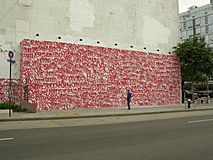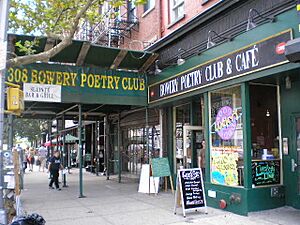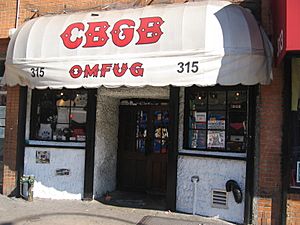Bowery facts for kids
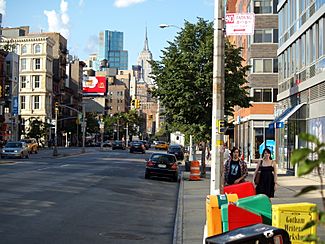
Looking north from Houston Street
|
|
| Former name(s) | Bowery Lane (prior to 1807) |
|---|---|
| Length | 1.6 km (1.0 mi) |
| South end | Chatham Square |
| North end | East 4th Street (continues as Cooper Square) |
The Bowery (pronounced: BAO-er-ee) is a famous street and neighborhood in Lower Manhattan, New York City. This street runs from Chatham Square in the south up to Cooper Square in the north. The Bowery neighborhood is roughly located between Allen Street and First Avenue to the east, and Little Italy and NoHo to the west. It is also next to Chinatown and the Lower East Side.
In the 1600s, this road was a path leading to the farm of Peter Stuyvesant. He was the leader of New Netherland, which was a Dutch colony before it became New York. The street was called Bowery Lane until 1807. The name "Bowery" comes from the old Dutch word bouwerie, which means "farm." This is because the area had many large farms in the 17th century.
Today, the New York City Subway has a Bowery station near Delancey Street. You can also catch the M103 bus along the entire Bowery. There is even a tunnel under the Bowery that was planned for a subway line that was never built.
Contents
History of the Bowery
Early Days: Colonial and Federal Periods
The Bowery is the oldest road on Manhattan Island. It started as a path used by the Lenape Native Americans, running almost the whole length of the island. When the Dutch settled Manhattan, they called it Bouwerij road. This was because it connected farms outside the city to the main part of the city, near today's Wall Street.
In 1654, the first people settled in the Bowery area near Chatham Square. Ten formerly enslaved people and their wives built cabins and started a cattle farm there.
Peter Stuyvesant, the last Dutch Governor of New Amsterdam, retired to his farm on the Bowery in 1667. After he passed away in 1672, he was buried in his private chapel. His home burned down in 1778. Later, his family sold the chapel and graveyard, which is now the site of St. Mark's Church in-the-Bowery.
By 1766, the Bowery Lane had buildings and gardens along its first few streets. Lorenzo da Ponte, who wrote the words for some of Mozart's famous operas, even ran a fruit and vegetable shop on the Bowery in 1806.
The Bull's Head Tavern on the Bowery is famous because George Washington stopped there in 1783. He was on his way to see the British troops leave New York after the American Revolutionary War. The Bowery was once as important as Broadway as a main road. Even in 1869, it was still considered the "second principal street of the city."
Growing Up: The Bowery's Rise
As New York City grew, its edges moved further north. By the early 1800s, the Bowery was no longer just a farming area outside the city. It became a respected and elegant street. Wealthy and famous people, like the industrialist Peter Cooper, moved their homes there. The Bowery started to be as fancy as Fifth Avenue.
In the 1820s, Lafayette Street opened next to the Bowery. The Bowery Theatre was built by rich families in 1826. It was the largest theater in North America at that time. Across the street, the Bowery Amphitheatre opened in 1833, showing popular horse shows and circuses. Over time, the types of shows at the Bowery Theatre changed as the neighborhood became less fancy.
A New Beginning: The Bowery's Revival
After the 1970s, the number of people without homes on the Bowery decreased. This was partly due to the city's efforts to help them. Since the 1990s, the entire Lower East Side area has been improving.
By 2005, new buildings and businesses were changing the Bowery. Many new tall apartment buildings were built. In 2006, AvalonBay Communities opened a luxury apartment complex with a fancy Whole Foods Market. More developments followed. In 2007, the New Museum of Contemporary Art opened its modern building on the Bowery.
This new development has brought some challenges. The documentary Sunshine Hotel showed the lives of people living in some of the last remaining simple, cheap hotels in the area.
Today, the Bowery from Houston Street to Delancey Street is a main market for restaurant equipment. From Delancey to Grand Street, it's known for lamp shops.
Bowery Areas
Upper and Lower Bowery
The upper Bowery is the part of the street north of Houston Street. The lower Bowery is the part south of Houston Street.
Bowery Historic District
In October 2011, the Bowery Historic District was added to the New York State Register of Historic Places. This means it was also nominated for the National Register of Historic Places. A local group called Bowery Alliance of Neighbors (BAN) helped make this happen. This special status gives property owners financial help to fix up old buildings instead of tearing them down. The historic district runs along both sides of the Bowery from Chatham Square to Astor Place.
Little Saigon
New York has an unofficial "Little Saigon" on the Bowery between Grand Street and Hester Street. While this area blends in with nearby Chinatown, it is full of Vietnamese restaurants.
Notable Places on the Bowery
Amato Opera
The Amato Opera company was started in 1948 by Tony and Sally Amato. It found a permanent home at 319 Bowery. This company gave many young singers a chance to perform in full operas. The Amato Opera closed on May 31, 2009, when Tony Amato retired.
Bank Buildings
The Bowery Savings Bank started in May 1834, when the Bowery was a fancy street. Its main building from 1893 at 130 Bowery is a special New York City landmark. The Citizens Savings Bank building from the 1920s, with its dome, is also a landmark.
Bowery Ballroom
The Bowery Ballroom is a popular place for live music. The building, at 6 Delancey Street, was built just before the Stock Market Crash of 1929. It was empty for a long time until after World War II, when it became a fancy store. The neighborhood changed, and so did the businesses there. In 1997, it became a music venue. It can hold 550 people.
The Bowery station of the New York City Subway is right in front of the venue's entrance. The club is so famous that Joan Baez recorded her album Bowery Songs there in 2004.
Bowery Mural
The Bowery Mural is an outdoor art space at the corner of Houston Street and the Bowery. Goldman Properties has owned the wall since 1984. Real estate developer Tony Goldman started this project in 2008. His goal was to show art by top artists from around the world, especially those who create street art. New murals appear on the wall each season.
Bowery Poetry
Bowery Poetry is a performance space at Bowery and Bleecker Street. It opened in 2001 as the Bowery Poetry Club (BPC). It became a home for both famous and new artists. Bob Holman, who owned the building, founded it. The BPC hosted regular shows by poets like Amiri Baraka and Anne Waldman. It also had open mic nights and poetry slams. The club closed in 2012 but reopened in 2013 as "Bowery Poetry," a shared performance space.
Bowery Theatre
The Bowery Theatre was a playhouse in the 1800s at 46 Bowery. Rich families built it in the 1820s to compete with another fancy theater. By the 1850s, the theater started to serve immigrant groups like the Irish, Germans, and Chinese. It burned down four times in 17 years. A fire in 1929 destroyed it for good.
CBGB
CBGB was a famous music club. It opened to play country, bluegrass, and blues music (that's what CBGB stands for). But in the mid-1970s, it started booking bands like Television, Patti Smith, and the Ramones. This led to a whole new music scene with bands like Talking Heads and Blondie. These bands played original, raw, loud, and fast music. The term punk rock was used for this scene, and CBGB became known as the birthplace of American punk rock. CBGB closed on October 31, 2006. The space is now a John Varvatos clothing store.
Miner's Bowery Theatre
Miner's Bowery Theatre was a vaudeville theater opened by Senator Henry Clay Miner in 1878. The theater was known for its "amateur nights," where anyone could perform. It was also famous for how it removed bad performers from the stage: by yanking them off with a wooden hook! This is where the phrase "Give him the hook" came from.
New Museum
In December 2007, the New Museum opened its new building at 235 Bowery. It continues to focus on showing art by international artists, women artists, and artists of color. This new building, designed by the Japanese firm Sejima + Nishizawa/SANAA, has greatly expanded the museum's space. In March 2008, the museum's new building was called one of the architectural seven wonders by Conde Nast Traveler. The museum also has a "Bowery Project" that honors artists who lived on the Bowery with interviews and old records.
Famous People from the Bowery
- Béla Bartók lived at 350 Bowery in the 1940s.
- Blondie lived at 266 Bowery.
- William S. Burroughs had an apartment at 222 Bowery from 1974 to 1981.
- Jim Gaffigan lives with his family in an apartment on the Bowery.
- Michael Goldberg lived at 222 Bowery.
- Eva Hesse lived in her studio at 134 Bowery.
- Charles Hinman, an abstract artist, lives next to the New Museum.
- Owen Kildare, an American writer, described life in New York slums.
- Ronnie Landfield, an abstract painter, lived at 94 Bowery.
- David McReynolds, a peace activist, lived near the Bowery.
- A. C. Bhaktivedanta Swami Prabhupada lived on Bowery when the Hare Krishna Movement started in America in 1966.
- Joey Ramone lived in the area. A part of 2nd Street near the Bowery was renamed Joey Ramone Place in 2003.
- Terry Richardson lives in his studio on Bowery.
- Mark Rothko, an Abstract Expressionist painter, had a studio at 222 Bowery.
- Cy Twombly lived at 356 Bowery in the 1960s.
- Tom Wesselmann had a studio on Bowery next to the New Museum.
- Jimmy Wright (artist), artist.
- Peter Young lived at 94 Bowery.
The Bowery in Pop Culture
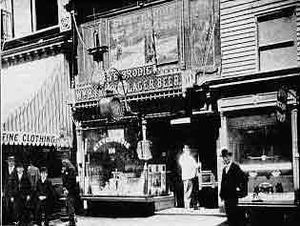
Books and Literature
- The Bowery is the setting for Stephen Crane's novel, Maggie: A Girl of the Streets (1893). It tells the story of a poor family living in the neighborhood.
- In Jack Kirby and Stan Lee's Fantastic Four #4 (1962), the Human Torch goes to the Bowery. There, he finds the character Namor the Sub-Mariner.
- The Wild Cards book series describes the Bowery as "Jokertown." This is a place where people with unusual appearances go to live after a special virus is released over New York.
Music
- The Bowery is mentioned in many songs. For example, the Bob Dylan song "Bob Dylan's 115th Dream" (1965) talks about the "Bowery slums."
- Exuma, a folk singer from the Bahamas, has a song called "The Bowery" on his 1971 album. It describes the area as a place where people faced hard times.
- The rock band Bowery Electric got its name from the area, where one of its members lived.
Stage and Theater
- The phrase "On the Bowery" used to mean someone was down on their luck. It came from the song "The Bowery" in the 1891 musical A Trip to Chinatown.
- On the Bowery was an 1894 play starring Steve Brodie. He was a famous Bowery saloon owner who claimed to have jumped off the Brooklyn Bridge.
- In Disney's musical Newsies, the showgirls are called the Bowery Beauties.
Movies and TV
- The 1925 film Little Annie Rooney takes place in the Bowery.
- The Bowery is a 1933 film about Steve Brodie, starring George Raft.
- A popular series of B-movies from 1946 to 1958 featured "The Bowery Boys."
- The 1949 cartoon "Bowery Bugs" tells a funny version of the Steve Brodie story, with Bugs Bunny involved.
- On the Bowery, a 1956 film by Lionel Rogosin, was nominated for an Academy Award for Best Documentary.
- In the 2002 film Gangs of New York, the Bowery is mentioned as the territory of the Bowery Boys gang.
- A crime boss named the Bowery King, played by Laurence Fishburne, is a main character in the John Wick movies.
Art
- The Bowery in Two Inadequate Descriptive Systems is a collection of photos and poems by Martha Rosler.
Advertising
- In the 1960s, commercials for the Bowery Savings Bank had a jingle. It said, "The Bowery, The Bowery / The Bowery pays a lot / The Bowery pays you 6% / Commercial banks in New York simply do not." The interest rate changed over time.
Wrestling
- Professional wrestler Raven is said to be from the Bowery in his wrestling character. However, the wrestler Scott Levy was born in Philadelphia.
Images for kids
See also
 In Spanish: Bowery para niños
In Spanish: Bowery para niños







